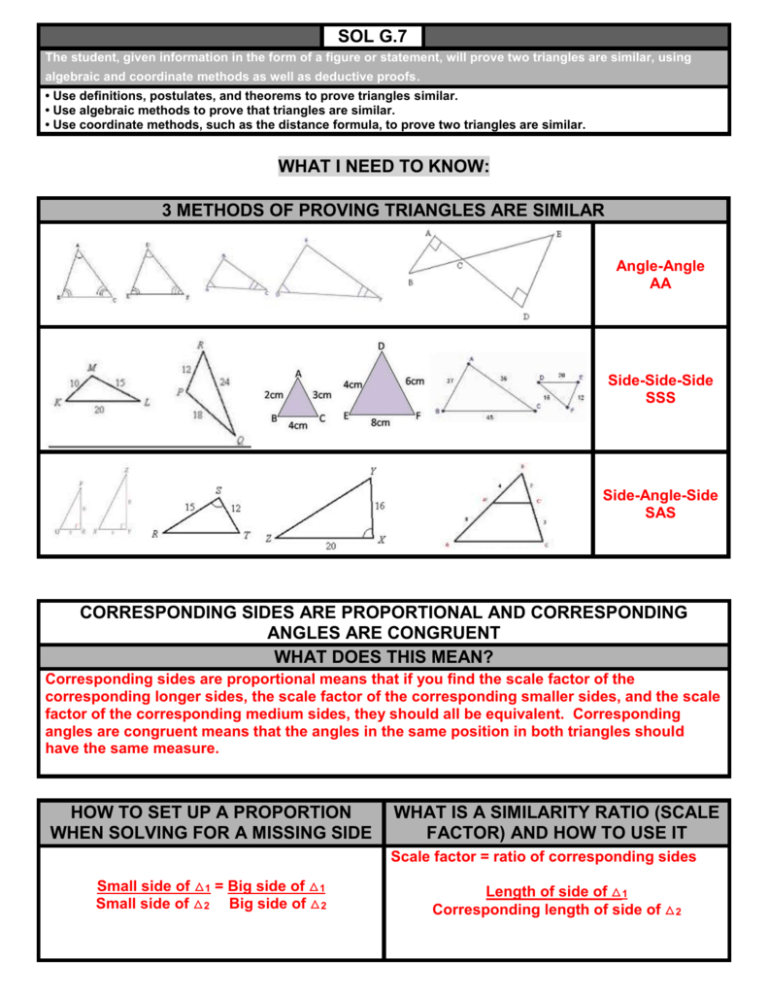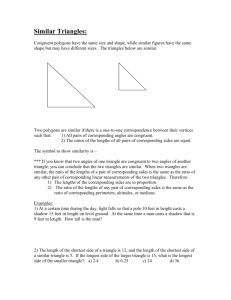SOL G.7
advertisement

SOL G.7 The student, given information in the form of a figure or statement, will prove two triangles are similar, using algebraic and coordinate methods as well as deductive proofs. • Use definitions, postulates, and theorems to prove triangles similar. • Use algebraic methods to prove that triangles are similar. • Use coordinate methods, such as the distance formula, to prove two triangles are similar. WHAT I NEED TO KNOW: 3 METHODS OF PROVING TRIANGLES ARE SIMILAR Angle-Angle AA Side-Side-Side SSS Side-Angle-Side SAS CORRESPONDING SIDES ARE PROPORTIONAL AND CORRESPONDING ANGLES ARE CONGRUENT WHAT DOES THIS MEAN? Corresponding sides are proportional means that if you find the scale factor of the corresponding longer sides, the scale factor of the corresponding smaller sides, and the scale factor of the corresponding medium sides, they should all be equivalent. Corresponding angles are congruent means that the angles in the same position in both triangles should have the same measure. HOW TO SET UP A PROPORTION WHEN SOLVING FOR A MISSING SIDE WHAT IS A SIMILARITY RATIO (SCALE FACTOR) AND HOW TO USE IT Scale factor = ratio of corresponding sides Small side of △1 = Big side of △1 Small side of △2 Big side of △2 Length of side of △1 Corresponding length of side of △2 G.7 PROBLEMS: ∠𝑪𝑫𝑨 ≅ ∠𝑩𝑨𝑫; ∠𝑪𝑩𝑨 ≅ ∠𝑩𝑪𝑫 Angle-Angle (AA) Postulate Statements 1. ̅̅̅̅ 𝐴𝐵 ∥ ̅̅̅̅ 𝐶𝐷 2. ∠𝐵𝐴𝐹 ≅ ∠𝐶𝐷𝐹 Reasons 1. Given 2. Alternate interior angles are congruent. 3. ∠𝐴𝐵𝐹 ≅ ∠𝐷𝐶𝐹 3. Vertical angles are congruent. 4. . △ 𝐴𝐵𝐹 ≅△ 𝐷𝐶𝐹 4. AngleAngle (AA) Postulate SOL G.8 The student will solve real-world problems involving right triangles by using the Pythagorean Theorem and its converse, properties of special right triangles, and right triangle trigonometry. • Determine whether a triangle formed with three given lengths is a right triangle. • Solve for missing lengths in geometric figures, using properties of 45°-45°-90° triangles. • Solve for missing lengths in geometric figures, using properties of 30°-60°-90° triangles. • Solve problems involving right triangles, using sine, cosine, and tangent ratios. • Solve real-world problems, using right triangle trigonometry and properties of right triangles. • Explain and use the relationship between the sine and cosine of complementary angles. CALCULATOR MODE degree WHAT I NEED TO KNOW: WHAT FORMULAS TO USE FROM THE FORMULA SHEET AND WHEN TO USE THEM WHEN TO: WHEN TO: ADD SUBTRACT MULTIPLY DIVIDE USE INVERSE Know legs, trying to find hypotenuse Know hypotenuse and one leg, trying to find other leg Variable on top Variable on the bottom Trying to find the angle, 𝝑 HOW TO DETERMINE WHETHER A TRIANGLE FORMED WITH THREE GIVEN LENGTHS IS A RIGHT TRIANGLE Use the converse of the Pythagorean theorem. Is c2 equal to a2 + b2? C is the hypotenuse. A and B are the legs. Put c2 in your calculator. Put a2 +b2 in your calculator. Check to see if they are equal. SPECIAL RIGHT TRIANGLES 𝟒𝟓° − 𝟒𝟓° − 𝟗𝟎° 𝟑𝟎° − 𝟔𝟎° − 𝟗𝟎° STEPS TO SOLVING FOR MISSING SIDE OR ANGLE USING TRIG. RATIOS Circle the acute reference angle. (𝝑) STEP 1: Label the 3 sides. H-hypotenuse, OSTEP 2: opposite side of 𝝑. A-adjacent side of 𝝑. Cross out which side does not have a partner. STEP 3: Choose trigonometric ratio based on given information and copy equation. STEP 4: Solve equation The cosine of an acute angle of a right triangle is congruent to the sine of the complementary angle of that same triangle. G.8 PROBLEMS: 23.7 ft




